|
|
 |
|
|
French Expeditionary Corps
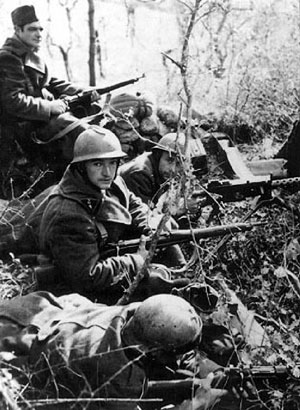 |
A Matter of Honour:
French Expeditionary Corps for Flames Of War
by Scott Elaurant, Phil Bradley and Simon McBeth
Historical Background
“It is a matter of honour”, General Juin to General Monsalbert, before the assault on Colle Belvedere, Italy, 23 January 1944.
Formation of the French Expeditionary Corps
No military force suffered more than the French army in the Mid-War period. The defeat of 1940 had left the French military painfully divided.
|
|
There were those who felt duty bound to remain loyal to the Vichy government, a few who had escaped to join the Free French under De Gaulle, and many troops scattered though the colonies unsure which way to turn. Some even fought against the Allies, notably in Syria.
The Torch landings in North Africa at first did little to resolve the situation. Local commanders were sympathetic, but theatre CIC Admiral Darlan was pro-Vichy and ordered the French to resist the Allies. This did not endear them to the Allied high command, especially US General Mark Clark who would later be a key figure in their fighting in Italy. Eventually a truce was agreed. A few units under the patriotic General Barre fought with the American troops in Tunisia in 1943. The Free French Brigades under Leclerc and Koenig continued to fight with the British Eighth Army. However most of the French troops were only slowly equipped by the Allies, and their quality was considered as suspect as their loyalty to the cause. Nevertheless, under more patriotic leaders like General Giraud and General Juin over 230,000 Frenchmen eventually joined the Allied cause in North Africa.
|
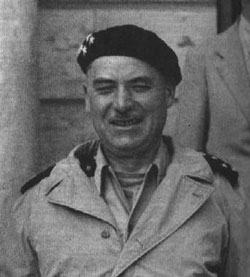 |
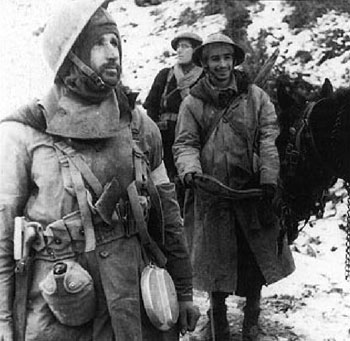 |
Giraud and Juin desired to form a united French army to help liberate France from the Axis, but they knew it would take time. First they had to form and train them into a cohesive force. The soldiers were mostly volunteers and consisted of the remnants of 60,000 Vichy Colonial troops, 12,000 Free French, and some 20,000 emigres who survived the perilous journey out of Vichy France via Spain. The majority - over 100,000 - were local volunteers, French Europeans living in North Africa and native North Africans. The entire force was organised into eight Divisions along US lines and received American weapons, though often of second-line quality. The Free French had to return their British supplied weapons to the Eighth Army. The Allies only committed a handful to the Sicilian invasion and none initially to Italy. The enforced delay gave General Juin time to train and weld them into a united force.
Deployment to Italy
Despite the prejudices of the Allied high command, by early 1944 a chronic shortage of infantry made use of the French essential in Italy.
|
|
The Allies were trying to batter their way through the Gustav Line south of Rome. Some of Juin’s forces were transported to Italy as individual divisions.
Eventually permission was gained to form a corps structure. By mid-1944 the French Expeditionary Corps (FEC) in Italy consisted of five well trained divisions:
3e Division d’Infanterie Algerienne (3 DIA)
2e Division d’Infanterie Marocaine Division (2 DIM)
4e Division d’Infanterie Marocaine Division (4 DIM)
1e Division Française Libre (DFL) (1st Free French Division); it was later called
1e Division Motorisee d’Infanterie (1st Motorized Infantry Div). (1DMI)
Goum Force (3 regiment sized Tabors)
|
|
Before Cassino
In Late 1943 Allied forces in Italy under Field Marshall Alexander had cleared the Axis from south of Naples and were approaching the Germans prepared defence line – the Gustav Line, which stretched across Italy at its narrowest point, in mountains south of Rome. Initial attempts to breach the Gustav Line were costly failures. On the eastern (Adriatic) coast the British Eighth army under General Brian Lees, tried to cross the Sangro River. The Canadian Division eventually cleared the town of Ortona after suffering heavy casualties. But Lees could not outflank the Sangro River line, which stretched all the way to the central Italian range. It was a stalemate. Eighth army units were transferred to the west coast for a combined attack.
On the western (Mediterranean) coast the US Fifth Army under General Mark Clark at first made good progress.
|
|
US II Corps crossed the Volturno River and captured Mount Maggiore to close up on the Gustav Line. The FEC was attached to VII Corps of US Fifth army and was now used for the first time. General Juin had deliberately kept their vehicles and heavy weapons to a minimum for mobility in the mountains. Now the Morrocan and Algerian Divisions, 3 DIM and 2 DIA, attacked through the mountains on the right side of Cassino to reach the Gustav Line. They performed well and the assault was only barely stopped by German reserves.
But Clark as yet had little faith in the French. The main assault on the Gustav Line would be by British X Corps across the Garigliano River, and by US II Corps across the Rapido River near Cassino.
|
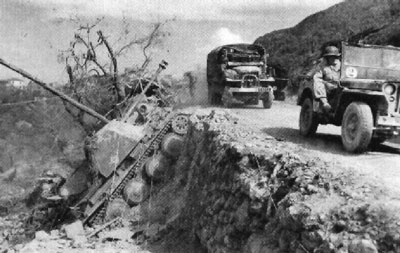 |
|
X Corps crossed the river before being halted on the heights of the west coastal range, the Arunci Mountains. Meanwhile the US 36th Division was mauled trying to cross the Rapido River and fell back. The adjacent US 34th Division had been making some progress up Monte Cassino to the east, but was now trapped on the slopes with open flanks. It would be up to the FEC to help.
General Clark asked the FEC to mount an attack on the mountain east of Monte Cassino, Colle Belvedere. This was no easy task. Colle Belvedere was 2000 metres high, with a sheer dominating ridge face of almost 600 metres. The line was fortified with bunkers and mines, and defended by units of the German 44th and 71st Infantry Divisions. The Rapido River would have to be crossed merely to reach the position. Yet General Juin knew he could not refuse Clark’s request if the Allies were to take the FEC seriously. As he said to General Monsalbert “It is a matter of honour”.
On 25 January the 2 DIA led the attack, crossing the Rapido with speed and stealth rather than firepower, and making good progress.
|
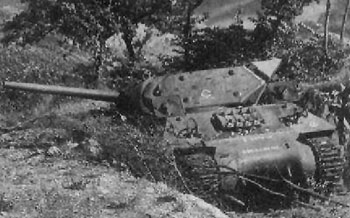 |
Yet as the regiments made their way up the steep slopes, they began to suffer losses from murderous German crossfire from the mountains above. Remarkably, they made the foot of the cliff and then, using its steepness to provide cover, climbed up over three hours to emerge and assault the defenders on top. After suffering horrific losses they captured Point 915 and Colle Abate in the centre of the ridge and the enemy’s defence line.
Over the next two days German reserves first threw them back, but follow up troops of 3 DIM recaptured the heights and held onto them. Indeed, if more reserves had been available the French may have been able to capture Attina and outflank the Cassino position from the east, forcing a German withdrawal. But Clark had only ever seen the FEC assault as a diversion and no reinforcements were forthcoming.
|
| With the Allies now pinned down on the mountains to east and west of Cassino, the offensive degenerated into a series of costly assaults up Route Six through the middle. These inevitably had to pass through the town and the adjacent Monte Cassino, with its dominant monastery. Over the next four months three successive attempts to break through the German positions would end in bloody failure. In part this was due to the epic resistance of the German 1st Fallschirmjager Division. But a series of predictable and uncoordinated Allied frontal assaults were also to blame. General Juin, aware of his Corps’ ability to move through the mountains, suggested that the position be outflanked, but was ignored by Alexander and Clark. British, New Zealand, Indian and US Divisions all suffered heavy casualties instead. |
Breaking the Gustav Line
Finally in April 1944 Alexander directed that there would be a coordinated offensive along the width of the entire front.
Once again the FEC would be used in a support role, to attack the line through the coastal Arunci Mountains west of Cassino. But this time the FEC would be used as a united Corps. Juin’s offensive was immediately successful, cracking the Gustav Line and outflanking the Cassino position. Although the FEC did not capture Cassino, their success forced the gradual withdrawal of German troops from Cassino. This made the capture of monastery by General Anders’ Polish Corps possible, after a brutal struggle, on 18 May 1944.
|
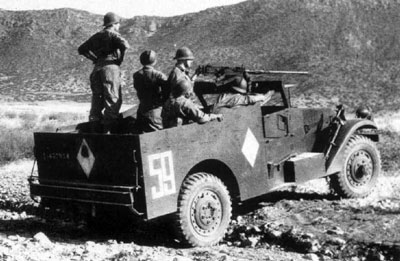 |
General Mark Clark recognised the efforts of the FEC in breaking the Gustav Line:
"Meantime, the French forces had crossed the Garigliano (River) and moved forward into the mountainous terrain lying south of the Liri River. It was not easy. As always, the German veterans reacted strongly and there was bitter fighting. The French surprised the enemy and quickly seized key terrain including Mounts Faito Cerasola and high ground near Castelforte. The 1st Motorized Division helped the 2nd Moroccan division take key Mount Girofano and then advanced rapidly north to S. Apollinare and S. Ambrogio. In spite of the stiffening enemy resistance, the 2nd Moroccan Division penetrated the Gustav Line in less than two day’s fighting.”
"The next 48 hours on the French front were decisive. The knife-wielding Goumiers swarmed over the hills, particularly at night, and General Juin’s entire force showed an aggressiveness hour after hour that the Germans could not withstand. Cerasola, San Giogrio, Mt. D’Oro, Ausonia and Esperia were seized in one of the most brilliant and daring advances of the war in Italy, and by May 16 the French Expeditionary Corps had thrust forward some ten miles on their left flank to Mount Revole, with the remainder of their front slanting back somewhat to keep contact with the British 8th Army.”
"For this performance, which was to be a key to the success of the entire drive on Rome, I shall always be a grateful admirer of General Juin and his magnificent FEC." |
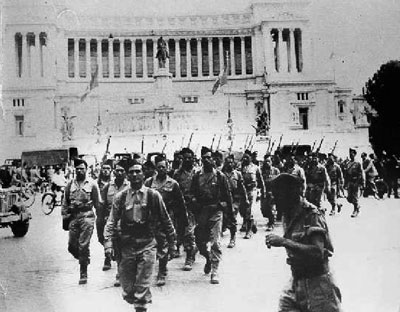 |
By 5 June the Allies captured Rome and advanced onwards to northern Italy. For the FEC though, their time was over. In September they were withdrawn from the front and joined the Free French Army invading Southern France. Unfortunately for Juin, political manoeuvring by de Gaulle saw he and de Tassigny command French forces in France and Juin returned to Tunisia. The Goums too were split up and added to the divisions. Despite their success in battle, appalling violence outside combat made them notorious. Numerous assaults and the murder of over 100 Italian civilians in the Ciociaria area meant they would not be allowed to operate as a single force again.
Organisation of FEC in Italy
The French were organised as follows under the US 5th Army.
|
1e Division Française Libre (DFL) (1st Free French Division) or 1st Division Motorisee d’Infanterie (1st Motorized Infantry Div) (1DMI). The 1st DFL was formed in February 1943 out of a combination of the 1st and 2nd Free French Brigades. After a reorganization in August, it was designated as the 1e Division Motorisee d’Infanterie (1st Motorized Infantry Div) and then again as the 1e Division de Marche d’Infanterie, which is a general term use by French for a mixture of diverse units. This division arrived in Italy in April 1944 and continued to be called the Free French Division and 1st Motorized Infantry Division. It took part in Diadem.
2e Division d’Infanterie Marocaine (DIM) (Moroccan Infantry Division) The 2nd DIM was formed on 1 May 1943 and was the first French formation on active service in Italy. It arrived in Italy in end November 1943 and fought in all the FEC battles.
3e Division d’Infanterie Algérienne (DIA) (Algerian Infantry Division). The former Division of Constantine was a colonial unit stationed near the Tunisian border when the Allies landed in North Africa. They participated in the operations that led to the liberation of Tunisia. On 3 May 1943 they were combined with new local recruits and redesignated as the 3rd DIA or 3rd Algerian Infantry Division. After some amphibious training 3 DIA embarked for Italy and relieved the US 45th Division. It led the assault at Colle Belvedere. |
|
4e Division Marocaine de Montagne (DMM) (Moroccan Mountain Division) The 4th DMM was originally formed as the 3e Division d’Infanterie Marocaine but changed to the 4th DMM. Later it was renamed simply the Division Marocaine de Montagne, but it continued to be referred to as the 4th DMM. Units of this division participated in the liberation of Corsica in September & October 1943 and later fought in Italy.
There were also almost a division of Goums, organised into Rifle platoons, company groups, battalions (called Tabors) and ultimately three regiment-sized Tabor groups.
Depicting French Troops
Most of the French troops in Italy fought in US uniforms and vehicles, thus Battlefront’s range of Late War US miniatures are the best choice. Equipment included M3 Scout Cars, M5 Stuarts, M10s, M8s, 40mm Bofors, 105mm and 57mm guns. Vehicles were all US supplied. Markings and insignia were uniquely French though, with the Lorraine Cross popular on vehicles.
|
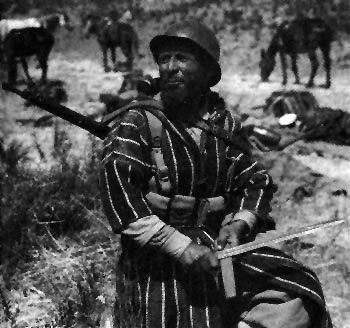 |
|
Most infantry wore US uniforms and helmets. Of course, there were exceptions too. A few veterans still had their French LMGs and World War One style helmets from the Early War period. Many officers wore the Kepi.
The Goums still fought in their original uniforms with distinctive vertical striped colour scheme of brown and white or grey. A demi-brigade (2 battalions) of French Foreign Legion troops also fought in their French uniforms, including the Kepi with neckflap made famous in the desert. The survivors of LeClerc’s Free French force from the North African campaign were re-equipped with US weapons for logistical reasons, but some of them probably also still had their Kepis. Mule trains and mounted Goums offer great scope for modellers.
The French Expeditionary Corps in Flames Of War
You can now field French forces in 1944 and 1945 using the D-Day: American and Bulge: American books combined with French themed Command Cards.
|
Last Updated On Thursday, October 21, 2021 by Wayne at Battlefront
|
|
|